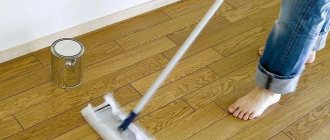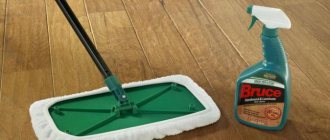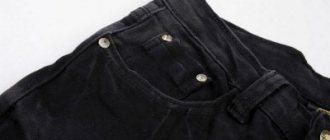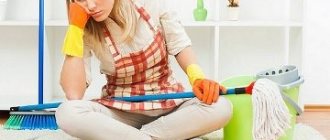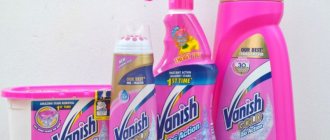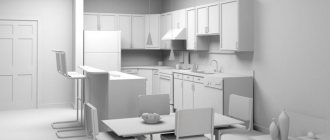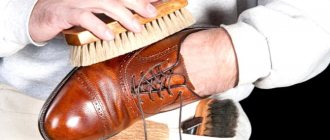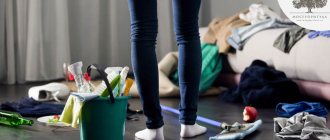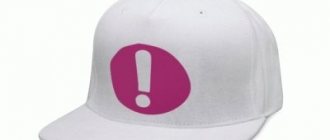Such a banal procedure as washing the floors can confuse the housewife if the flooring is heavily soiled, ingrained stains, or traces of recent repairs. Not everyone knows how to properly clean floors covered with ceramic tiles, laminate or carpet. Meanwhile, the ancient Chinese teaching of Feng Shui speaks of a direct relationship between a clean floor and the presence of positive energy in the house.
You will be surprised, but cleaning company specialists generally recommend washing the floors in your apartment no more than... two or three times a year! It’s just that “washing” and “wet cleaning”, as it turns out, are two different concepts. In the second case, the procedure is carried out regularly. But general cleaning of the floor covering using additional detergents should not be frequent so as not to damage the surface.
Optimal frequency
If we talk about the frequency of wet cleaning in the house, there are no established standards, as, for example, in a hospital, where rooms need to be washed two to three times a day. In an apartment, everything depends on the type of flooring, the composition and lifestyle of the family, and the time of year. For example, in a house with linoleum, where two working adults and a schoolchild live, the floors need to be washed:
- in summer - every other day;
- in winter - several times a week.
At the same time, it is advisable to treat the hallway, kitchen and children's room daily, regardless of the time of year and type of floor. To keep up with wet cleaning and not take much time, keep the equipment at hand. And teach your household to simple rules: wipe your shoes immediately upon returning home, put things on their shelves, do not accumulate dirty dishes and garbage.
Types of flooring
Let's briefly look at the main types of flooring:
- batten. Floorboards made of larch and oak tolerate changes in humidity and temperature well, but flooring made of spruce, pine and ash can rot at high humidity. It is recommended to wipe such boards with a dry cloth after washing;
Floorboard - an inexpensive and environmentally friendly floor covering - laminate. Laminate flooring is extremely negatively affected by high humidity in the room (above 60%) - it begins to “swell”, the boards stick out and seem to bubble at the edges. To prevent this from happening, make sure that after washing the floor there are no puddles left anywhere;
A swollen laminate looks extremely unattractive - parquet and parquet boards. This is an expensive floor covering, but its cost is justified. Over time, varnished parquet becomes immune to changes in temperature and humidity, however, for the first five to seven years after installation, it is necessary to maintain a room temperature of 19–25°C and a humidity of 40–60%. Deviation from these parameters in the first years can deform the boards;
When deformed, the parquet boards move relative to each other, which makes the floor uneven - linoleum. To prevent linoleum from deforming when humidity increases or temperatures are too high, when laying, leave a gap of about 1 cm between the wall and the floor covering. If this requirement is not met, then bubbles and swelling may appear during cleaning, so it is recommended to wipe the linoleum dry after washing ;
If linoleum is not installed correctly and is exposed to high humidity, it may become covered with bubbles. - ceramics and porcelain stoneware. Ceramic tiles are durable, beautiful and environmentally friendly. It is insensitive to high humidity, so it is often installed in the bathroom, toilet and kitchen. You can wash it regularly without fear of deformation;
- liquid (self-leveling) floor. Liquid flooring is durable, safe, and does not deteriorate from various chemical compounds. Like ceramics, it is absolutely insensitive to changes in humidity, but it can be scratched by abrasives or a hard brush.
Liquid flooring (also called self-leveling) looks very impressive, but is rarely found in private apartments and houses
Necessary equipment
Before you start cleaning the floors, you need to prepare the room, equipment and get ready for cleaning. We will need:
- rags;
- mop;
- bucket;
- brush;
- latex gloves;
- floor cleaning liquid.
For cleaning floors, preference should be given to rags made of synthetic and cotton fibers. For rubbing, it is better to take wool or flannel fabric. The bucket should be spacious and three-quarters filled with water.
Which rag should you choose?
Nowadays there is a very large assortment of floor cleaning cloths. Which one to choose? A floor cloth should combine two qualities: be soft and quickly absorb water. The choice of rag also affects what types of floor surfaces need to be washed.
The most popular types of floor cloths are: cotton, viscose and microfiber. Cotton floor cleaning cloth has the following advantages: it is made of natural material, soft, absorbs water well and is very durable. The disadvantages of this fabric include the fact that it wears out quickly and can leave streaks on the floor.
A viscose floor cleaning cloth has the following advantages: it is more durable than cotton cloth, which increases its service life, and also does not leave lint on the floor and absorbs water better. The main disadvantage of such a floor cloth is that it is not resistant to high temperatures, which means it needs to be rinsed in cool water.
And microfiber is relevant, which is now used by everyone and in different areas (washing cars, windows, etc.). The advantages of this fabric include the fact that it absorbs water very well, and after twisting it remains wet, almost dry, which makes it possible to wash any surface without streaks. One of the disadvantages is that it is contraindicated to dry it and it does not cope with fat.
Where to begin
Before you start cleaning, change into your “home clothes.” Your “outfit” should be soft, practical and not restrict movement. Wipe the soles of the slippers so that you don’t leave dust marks on the clean surface. Further:
- ventilate the rooms - and also remove dust from furniture and carpets;
- free up space - you should roll up and remove carpets, raise chairs, floor vases, lamps and other oversized interior items;
- wipe the legs - these are the parts of the furniture that “catch” dust, hair, dirt;
- remove debris with a wet broom or vacuum cleaner.
How to speed up the process?
Knowing some of the intricacies of washing a large amount of dishes will help speed up and ease this tedious routine process significantly.
Soak
In order to quickly, efficiently and, most importantly, effortlessly clean dried-on food particles, grease and other contaminants, the dishes must be soaked .
For such purposes, dirty spoons, forks, plates, cups are loaded into a large basin (alternatively, you can use a kitchen sink, after closing the drain with a stopper), and fill it with water (you can add a few drops of detergent). In this form, the dishes soak for thirty minutes.
Depending on the material used to make kitchen utensils, the temperature of the water for soaking varies.
So crystal glasses and decanters are filled only with cold water (crystal darkens from high temperatures).
Plastic, glass, porcelain products are soaked in warm water . Dishes coated with grease, metal cutlery, graters, meat grinders, frying pans and pots are filled with hot water with the addition of a special detergent.
Sorting
Dividing into groups will not only speed up the process of washing dishes, but will also protect kitchen utensils from damage (the risk of a heavy pan crushing fragile glass glasses is minimized).
So, first of all, cups, glasses, glasses (items that are easiest to break) are washed . Then plates, gravy boats, bowls, various vessels and jars are loaded into the sink.
Lastly, metal kitchen utensils, forks, spoons, and knives are washed in a separate group. The utensils in which fish dishes were prepared or served fall into a separate category. This will help prevent the unpleasant fishy smell from spreading to other kitchen utensils.
Choosing a detergent
In order for the dishwashing process to go quickly, you need to prepare the necessary equipment in advance and choose the right detergent.
So, for work you will need:
- double-sided foam sponges (the abrasive side will help to better clean stubborn dirt);
- metal scourers (an irreplaceable thing for cleaning cast iron frying pans and grill grates);
- viscose, cellulose, sponge napkins (good for both washing and drying already clean dishes).
When choosing a detergent, special attention should be paid to the composition. A good option is a liquid or gel product that contains a minimum amount of synthetic surfactants and a maximum amount of natural ingredients. Dry powders are not used as often (abrasive particles leave deep scratches).
It is strictly forbidden to wash dishes with washing powder, use bleach and other chlorine-containing products.
How to wash floors correctly: the intricacies of wet cleaning
After the preparatory stage is completed, visually divide the floor into small sections and proceed:
- use detergents - special floor cleaning liquids such as Pronto or Mr. Proper will allow you to easily deal with dirt and leave a pleasant aroma;
- start with hard-to-reach places - go with a mop under the bed, closet, table;
- move from the window towards the door, so as not to trample the washed areas;
- wash until the water is clear - wipe the floor until the water becomes clear;
- change the water often - as soon as it becomes slightly cloudy;
- wipe dry - remove any remaining moisture with a dry cloth so that there are no streaks left and the coating is not deformed;
- wash rags, nozzles, brushes - and also wash the bucket, and send the equipment to dry on the balcony until the next cleaning.
Tips for housewives
To quickly clean the floors at home, you need to adhere to the following rules:
- before cleaning, it is necessary to clean the work area - lift chairs, remove things and toys lying on the floor covering;
- all garbage must be swept into one pile with a damp broom or vacuumed;
- They begin to wash the floor from the far corner of the room, since the less you have to walk on the washed surface, the cleaner the house will be after cleaning;
- It is imperative to wash all the joints between the floor covering and the baseboards, gradually moving towards the exit;
- The water in the bucket must be changed as it gets dirty and this should be done as often as possible.
Thanks to these rules, you can quickly and efficiently carry out wet cleaning of indoor flooring.
Mop or hands
It doesn’t matter how you decide to wash the floor - with a mop or with your hands - you must follow the rules described above. The result will be achieved in both cases. But how to work more conveniently? Is it possible to wash floors by hand without streaks? Here you decide for yourself, focusing on the pros and cons described in the table.
Table - Features of washing floors with a mop and by hand
| How to wash floors | pros | Minuses |
| Hands | — Good for your figure (more calories are burned); — no need to spend money on a mop and attachments for it; — convenient to wash baseboards and corners; - the result seems to be of better quality; — heavy dirt can only be removed manually | — It takes more time; — it is difficult to treat hard-to-reach places under furniture; — it’s inconvenient to work with gloves, and without them the manicure will deteriorate; - there is a load on the back, arms and knees |
| mop | — Cleaning goes faster; — no load on the back, arms and knees; — it’s convenient to treat the floor under furniture; - hygienic; - if the mop has an automatic spin, your hands are not exposed to detergents | — A good mop is expensive; - skirting boards, corners and stubborn stains still have to be handled manually; - if you just need to quickly refresh “prominent places”, it’s more difficult to maneuver between carpets and furniture with a mop |
The most important
- Pay attention to the choice of equipment: a properly selected mop and rag will help you quickly and effectively clean the house.
- Remember that different floor coverings have their own characteristics: this is important to consider when choosing the right cleaner.
- Dose detergents correctly. Too much concentration of the active substance can damage the floor covering, leave stains or cause allergies. Weak solutions will not cope with the removal of strong contaminants.
- Do not allow excess water. Laminate, parquet, unpainted wooden boards, and cork deteriorate from exposure to moisture. The rag must be carefully wrung out so that it is slightly damp and not wet.
Folk remedies for different floorings
The territory of a modern home is not always limited to one type of flooring. Often, the floors in the bedroom are covered with one material, in the kitchen with another, and in the bathroom with a third. Modern housewives know how to quickly clean the floors in an apartment, regardless of their type, using both modern and folk remedies. Such methods are especially relevant when there is a “general cleaning” and you need to wash the coating from complex contaminants. The following cleaning products may be useful:
- powder (washing, cleaning);
- soap (laundry, liquid);
- ammonia;
- vinegar (citric acid);
- salt;
- glycerol;
- turpentine;
- mastic.
Unpainted plank floor
Peculiarities. This is an environmentally friendly coating. The floor is wooden and is called unpainted due to its external characteristics. Although, in fact, the boards are always treated with oil, varnish or wax. These are, in fact, also a kind of paint, only colorless, due to which the bars retain their natural appearance. You can remove stubborn stains from such a floor using the following method.
What to do
- Dilute two tablespoons of soap shavings in 6 liters of warm water.
- Treat the floor with the resulting solution using a brush with stiff bristles.
- Pour vinegar into clean cold water: two tablespoons per 6 liters of water.
- Wash the floor with acidified water using a soft cloth.
- Wipe dry.
Instead of soap, you can use a solution with bleach: you need three to four tablespoons of bleach for the same amount of water. Then you can avoid rubbing the contaminated areas too much. And in order to protect unpainted flooring from dampness and rotting, it is recommended to rub it twice a year with a rag dipped in turpentine.
Wooden painted floor
Peculiarities. He is not afraid of water. If the paint is good, it will not peel even under the influence of strong detergents. It is easy to remove dirt from such a coating. The only thing you need to do is make sure that the boards shine. Ammonia will help here.
What to do
- Dilute two tablespoons of ammonia in 6 liters of cold water.
- Wash the floor with the resulting solution.
- There is no need to rinse off the solution additionally.
Places where the oil paint has become slightly worn away over time can be rubbed with parquet mastic of a suitable color. This little trick will allow you to postpone repairs and keep your deck looking attractive.
Parquet and laminate
Peculiarities. Parquet and laminate are considered the most capricious types of flooring. Do not use abrasive cleaners or steam cleaners for cleaning. Do not allow moisture to get into the cracks, as this will cause the floor to swell. It is acceptable to use purchased products such as “Denkmit”. This product contains wax, carefully cares for the coating, protects it from the influence of UV rays and premature wear. If you do not use special care products, then remember: it is better not to wet such a floor too much. Just vacuum well, wipe with a damp cloth and carefully remove any remaining moisture by rubbing with a dry flannel until shiny. You can get rid of stubborn stains on the floor using washing powder.
What to do
- Mix one tablespoon of washing powder and a small amount of water into a paste.
- Apply to the stain and leave overnight.
- In the morning, rinse with warm water.
In the case of parquet, glycerin will help to wash the floor to make it shine. Dilute four tablespoons of the drug in a liter of water and wipe the floor with the solution. And for laminate they recommend this method: vinegar and very hot water. But do not leave puddles, work with a well-wrung out cloth.
Tile and ceramic tiles
Peculiarities. The most unpretentious floor is covered with tiles. It is easy to wash, clean from dirt, dust and stains. A smooth, glossy surface is washed as follows.
What to do
- Dilute four to five drops of ammonia in a bucket of water.
- If desired and available, add a tablespoon of dishwasher-safe brightener.
- Wash the floor with the resulting solution.
- Wipe dry.
Tiles with a rough surface are cleaned with a sponge or brush, using a soap solution or commercial products like Mr. Proper, Glorix, Cif. Heavy stains can be removed with Pemolux universal soda cleaner.
Linoleum
Peculiarities. Linoleum is not resistant to ammonia, soda powders, hot water, bleach and hard brushes. It is necessary to wash the linoleum covering quickly, otherwise the design may be damaged.
What to do
- Dissolve two tablespoons of soap shavings in 6 liters of water.
- Wash the floor with the resulting solution.
- Immediately run clean cool water over the top without allowing the soap to dry.
- If the linoleum is smooth, moisten a soft cloth in linseed oil and rub the floor.
Dark stains from linoleum are removed using a paste of ground chalk and water. The brilliant green from such a floor can be wiped off with nail polish remover or foam of laundry soap. Wiping with a cloth soaked in a solution of milk and water can add shine. Once every three months, linoleum must be rubbed with drying oil, and then polished with a soft silk cloth.
Carpet
Peculiarities. This is a coating that does not tolerate wet cleaning. It is best to clean it with special dry foam, using a vacuum cleaner to subsequently remove the product. Or use carpet cleaners. You can also use a washing vacuum cleaner or steam cleaner. In winter, the carpet, if it is possible to dismantle it, is cleaned in the snow. But how to remove stubborn stains?
What to do
- Mix three large spoons of rubbing alcohol with a spoon of vinegar.
- Moisten the stain and leave for half an hour.
- Remove the solution with a sponge.
General recommendations
It would seem that what could be easier than washing the floors? However, spontaneity in cleaning is not encouraged. Only verified and consistent actions will allow you to achieve crystal purity with minimal time. Every time you start cleaning, remember these nine recommendations on how to quickly wash the floors in your apartment.
- Free up as much space as possible. Chairs, poufs, floor lamps, flowerpots - everything that you can lift, take it out of the room in which you are going to wash the floors. This will speed up the cleaning process and improve its quality.
- Collect small debris. To do this, you need to vacuum the floors or sweep with a damp broom. If this is not done, you will have to wash the floors several times.
- Clean the carpet. Be sure to knock out or brush the runners and rugs before laying them on the washed floor.
- Pre-wipe the furniture. If you are planning a general cleaning, you need to remove dust from the furniture before washing the floors, so that dirt does not fly onto the clean surface later.
- Start from the perimeter. Before you start cleaning the main area of the room, wash the baseboards and corners.
- Change the water. After three or four rinses of the rag, be sure to change the water to clean water.
- Stay in the right direction. Washing the floors should begin in the farthest corner of the room and end at the entrance to the room. This way you won’t trample on already washed surfaces.
- Ventilate the room. Free circulation of fresh air will speed up the drying of the surface and neutralize the smell of detergents.
- Process your inventory. After finishing cleaning, be sure to wash the bucket with bleach or any other detergent. The rag or mop should be washed with powder at high temperature.
Be patient and do not walk on the floor until it is dry. Otherwise, stains and streaks will remain on the surface.
Universal methods for stubborn stains
By remembering a few universal techniques, you can easily deal with stains of any complexity on all types of coating.
- Dirt. The easiest way to wash it off is with washing powder or Fairy dishwashing detergent.
- Fat. To remove greasy deposits from the floor, mix baking soda and sunflower oil to the consistency of thick sour cream. Rub the floor with the resulting mixture and let stand for 10-15 minutes. And then, sweep away the remaining soda with a broom and wash with cold water.
- Mold. Washing floors with bleach can defeat it. The use of bleach requires compliance with proportions, the use of protective equipment and mandatory ventilation of the room. Add 10 g of bleach to 5 liters of water. The floor is washed with the windows open, when there are no children or animals in the house.
To make your floors shine, use table vinegar when washing - two large spoons per 10 liters of water. And for a pleasant aroma, you can add one or two drops of essential oil to the bucket.
Rules for general floor care
Cleaning as often as possible will reduce the time you spend on it. Please refer to the care recommendations for specific types of coatings. This will help protect the floor and give it a natural and aesthetic appearance.
Give preference to quality cleaning products.
Use folk remedies from the “definitely won’t do any harm” category. Regular cleaning is the key to freshness and cleanliness in any home!
Treatment after repair
The most difficult thing is to wash away traces of repairs from the floors. They remain marked by whitewash, putty, glue and paint. Before washing the floors after renovation, it is necessary to remove stains.
- Paint and glue. They are best removed with acetone or white spirit. If the glue is wallpaper, then it is washed off with ordinary warm water in several passes. Oil paint can be easily removed with Cif cream. If linoleum is dirty, try scrubbing the stain with vegetable oil. Fresh stains from water-based paint can be easily removed with a soap solution. If the “blots” are old and the coating tolerates moisture, moisten it with soapy water and leave for 15-20 minutes. Also, formic acid or isopropyl alcohol will remove stains after painting without much effort, without damaging the floor surface.
- Hardened putty and lime. First, carefully remove the plaque with a spatula, and then rinse off the residue with hot water and vegetable oil. You need 100 ml of product per bucket of liquid. Another effective way to clean the floor from whitewash is a solution of water and salt (100 g of spice per 5 liters of water).
After the stains have lifted, wash the floors clean as usual, depending on the type of coating.
Removing whitewash
Before starting repairs, the floor surface should be covered with paper or newspapers.
It is better not to use oilcloth, as it is slippery and you can slip on it. To clean the floors after whitewashing without causing streaks, you can use the following tips:
- Add a glass of grated soap to a bucket of water and let the liquid brew. The contaminated surface should be filled with a solution whipped into foam and the whitewash should be allowed to soak. After this, the foam is collected with a clean and damp cloth. The water in the bucket is changed and the floors are wiped again, after which they are dried with a soft rag.
- If the floor is very dirty, then before you start washing it, you need to break it into sections. Each of them is first washed with soapy water, then wiped dry with a cloth soaked in clean water. It is recommended to change the water after each stage. To quickly remove severe stains, add a little fine salt or aviation gasoline to the soap solution.
Using Vanish stain remover to clean upholstered furniture
Thus, in order to properly wash the floor, you need to know certain subtleties . Each coating is washed differently using different products. By following certain rules, you can quickly and efficiently wash any floor covering.
When to wash - morning or evening
It is interesting that old Slavic traditions and signs, like Feng Shui, endow the process of washing floors with a certain symbolism. For example, it is believed that one should not clean in the evening, otherwise the housewife will invite evil spirits into the house. And vice versa, if you clear the room of debris and dust during daylight hours, a woman will allow well-being, prosperity, and positive energy into her home. They also say that pregnant women should not wash the floor, otherwise they may cause premature birth.
But real life dictates its own conditions. Women usually work during the day, so household chores are left for the evening. And future mothers, in order not to get tired, know how to clean the floors with a mop. Moreover, they use “smart” equipment that even “twists” itself. “Helpers” with telescopic handles (rope, microfiber, sponge) have made the life of the modern housewife much easier.
How to clean tough stains
Special narrow (point) action products will help in the fight against complex stains, but sometimes you can get by with simple, folk remedies. But it is important to remember the characteristics of the materials. For example, if a tile can be thoroughly rubbed with a brush (especially one with a rough surface), then this will not work with laminate and parquet.
Special equipment will help you deal with difficult stains.
In the last two cases you need:
- use brushes only with soft bristles;
- do not use aggressive cleaning agents;
- Do not rely too much on the universality of folk methods (they are designed for simple, unpretentious materials).
IMPORTANT! When buying a new product, test its effectiveness on an inconspicuous area of the floor so as not to spoil the coating.
If there are pets in the house
Dogs or cats living at home can affect the cleanliness of the apartment. To remove hair accumulations, you must adhere to the following rules:
- When cleaning, pay attention to corners and hard-to-reach areas where the most dirt accumulates;
- It is best to remove hair using a special roller attachment for a vacuum cleaner;
- If you have a lot of pets and don’t have time for daily cleaning, you can buy the cheapest washing robot vacuum cleaner.
If your pet periodically marks the apartment, you should not wash the puddle with plain water - this will only increase the unpleasant odor and increase the contaminated area. The following products will help you clean your floors:
- Potassium permanganate. Dissolve 5 crystals in 200 ml of water - the liquid should turn out to be light pink. The sponge is moistened with the product, the stain is wiped, the floor is washed with clean water and wiped dry.
- "White". The composition is diluted in water in a ratio of 1:10, the contaminated area is treated, washed with clean water and wiped with a dry cloth.
- Washing powder. If there is a strong smell of urine in the room, dissolve 1-2 tablespoons in 5 liters of water. powder, wash the entire floor with the product. To consolidate the result, you can wipe the coating with medical alcohol diluted with water.
Scratches often appear on the floor from the claws of pets. You can deal with them using the following means:
- Wipe damage on the wooden floor with a walnut core;
- to remove scratches, prepare a mixture of vegetable oil and vinegar, rub it into the surface and leave to dry for 2 hours;
- To remove damage from the surface of natural oak or mahogany, you need to dissolve 5 drops of iodine in 200 ml of warm water and wipe the floor with the liquid.
It is recommended to test its effect on an inconspicuous area before using any product.
How to clean matte, satin and fabric stretch ceilings?
- The safest way to clean fabric ceilings is by dry cleaning (with soft flannel/microfiber rags). It is permissible to use the vacuum cleaner in low suction power mode (caution). In this case, the nozzle should be kept at a distance of 3-5 centimeters from the canvas. If you need to clean stains and dirt, you can use the same weak soap solution, treat the contaminated area with it and leave for 5 minutes. The main thing is not to overdo it with friction, otherwise marks may remain.
You can also wash the fabric ceiling using a special product as in the photo below.
- Satin ceilings can be washed in the same way as glossy ones (see instructions in the first chapter).
- Matte ceilings can be cleaned in the same way as glossy or satin ceilings. However, they cannot be cleaned with alcohol-based products (including ammonia).
The right way
- The very first thing is to get rid of any leftover food on your plates, pots or pans. It’s so unpleasant when small pieces of food begin to collect on the sponge during washing and remain on the washed surface. In addition, the sewer pipes will not clog quickly.
- Train yourself to sort dishes before washing. Your muscle memory will definitely help you speed up when you start washing the same type of dishes. How to wash the dishes correctly in this case: start with the cleanest and end with the dirtiest.
- Experienced housewives take up the cups first, smoothly move on to the cutlery, then wash the plates, and finish with pots, pans, and burnt baking sheets. By the way, such instructions on the procedure for washing dishes are prescribed even in children's institutions.
So, the rules for washing dishes do not slow down (as some believe) the process itself, but only speed it up, so try to adhere to them and do everything correctly.
Fast way
Since you can’t hide from dirty plates, pots and other household chores even in the modernized 21st century, try to increase the efficiency of performing routine work.
- The most important condition for how to quickly wash the dishes is to take care of the dirty plates without delay. Agree, it is much easier and faster to remove leftover food from dishes when nothing has dried out or stuck anywhere.
- What if you can’t wash the dishes right away? To prevent them from drying out, fill everything with warm water, add mustard powder, and let the contents of the kitchen sink take such a specific bath until you return. By the way, mustard added to the water will help the fat dissolve better.
- Choose the right tools for washing dishes by hand. The best option is a kitchen sponge. It perfectly washes away dirt and, unlike a regular rag, it quickly cleans itself of residual grease and food. It is better to use only natural, folk detergents.
How to remove complex stains?
Toothpaste and ammonia will help restore shine and shine to darkened stainless steel dishes. The ingredients are mixed in equal proportions and the resulting mixture is applied to the contaminated surface. In just a few minutes, your stainless steel cookware will shine like new.
Baking soda will help you remove black stains from tea or coffee without much effort, and also get rid of unpleasant odors. The powder is mixed with water to form a thick paste, which is rubbed onto the contaminated surface.
Mustard will help remove old grease from the glass surface . It is enough to dilute dry mustard powder with warm water to form a thick paste and treat dirty dishes with the resulting composition.
Traditional methods
You can wash quickly and cleanly without any chemicals - use a natural dishwashing detergent. It's time to remember traditional methods and use natural products for washing dishes by hand. But you definitely have them all in your kitchen - mustard, soda, vinegar and the essential laundry soap.
How to wash dishes in this case? When there are only a few plates, pour mustard powder directly onto the sponge and wipe the dirty surface. If the whole family has dined, pour hot water into the sink, add mustard powder, foam the solution - the harmless detergent is ready!
Wipe kitchen utensils with dry mustard more often: this way you will not only clean the surface of dirt, but also properly disinfect it even without the use of chemicals.

